Healthy cannabis plants can absorb more nutrients and grow faster than sick ones. This is the first thing to keep in mind when cultivating cannabis so you can have better harvests at the end of your growing season. You can always add more nutrients based on your plant’s response but when you either under-fertilize or over-fertilize, your plants will get stressed and damaged, which will negatively impact quality and yield. Remember that each cannabis strain is different so it follows that each will also require different levels of nutrients.
I recommend growing fewer plant varieties and mastering each individual cutting so every plant will have slightly different requirements, or focusing on a single variety of seeds as each plant will have exactly the same requirements. When growing several varieties, it’s hard to dial everything in. It’s far easier to mix one batch of nutrients than to make a different batch for each plant variety and every plant within a strain will also have different requirements. That’s why if you start with seeds, I recommend selecting your favorite female and growing cuttings from that one individual as with each grow, you’ll get better at mastering your chosen mother. There’s a wide genetic variance even in a pack of 10 seeds. No two seeds are the same. It’s better to master one than being average with many varieties.
When growing organically, pH is less important as microbes control pH levels – a fungally-dominated soil will be more acidic than a bacterially dominated soil which will be more alkaline. Cannabis prefers a bacterially dominated soil so I recommend making actively aerated compost tea, (AACT). To lower pH levels, make AACT out of bat guano if you’re concerned about the pH of your organic nutrient solution because most organic nutrients have a naturally low pH.
pH Problems & Common Cannabis Nutrient Deficiencies
There are lots of cannabis problems or cases of sick plants out there, and here’s a little help. The main issue usually boils down to pH problems and nutrient deficiencies. Having your pH at neutral levels will do the trick. A 6.8 pH level is perfect for soil while you should aim for 5.8-6.0 pH for hydroponics. This will help make nutrient deficiencies a lot easier to overcome.
When your cannabis plants suffer from nutrient deficiencies, older leaves are affected initially as mobile elements take on their nutrients, after which they work their way to younger leaves and newer growths. The following are mobile elements as well as macronutrients. First off, we are going to start with Nitrogen.
Nitrogen (N)
Benefits of Nitrogen
Nitrogen plays a very big role in cannabis growth and development. It is directly responsible for photosynthesis and the production of chlorophyll and amino acids, which are the building block of proteins. The myriad of enzymes help develop the leaves and stems and are responsible for the vigor of your plants. Nitrogen is the biggest mobile element, which means it travels everywhere on your cannabis
Nitrogen Deficiency
Nitrogen deficiency starts to manifest in the lower to the middle section of the plant and affects the older leaves first. The deficiency will then work its way upwards to newer growths. Your marijuana grow can be green on top, with yellowing more apparent on the lower leaves at the start of a deficiency. Along with the yellowing, leaves can turn purplish in really bad cases of nitrogen deficiency. Without good amounts of nitrogen in your plant, the yield will be significantly reduced.
Unlike a magnesium deficiency, nitrogen deficiency will start from the tips and work its way back to the leaf node. Nitrogen and magnesium deficiencies are often confused for the other. The best way to tell them apart is this – a nitrogen deficiency starts around the tips and works its way to the back of the leaves while a magnesium deficiency will cover the entire outer part of the leaf and make the entire leaves yellow, leaving the veins to stay green. If your cannabis plants are experiencing slow growth and leaves are turning yellowish, then most likely it’s a nitrogen deficiency.
More often than not, cannabis will show nitrogen deficiency towards the middle to end of the flowering stages. This is completely normal so just let the plant naturally yellow out as it uses up stored nutrients. In fact, this can be helpful with getting you ready for final flushing and then harvesting. At this point, DO NOT use Nitrogen to fix the problem. Yellowed leaves will eventually drop off after the plant uses up the nutrient stores.
Here are two pictures. The first one shows nitrogen deficiency, and the second one is an example of a non-deficient growth.


Nitrogen Toxicity
Now for having too much nitrogen in your growing medium or soil. There will be significantly delayed maturity and your cannabis plant will have an overall dark green color. Because nitrogen is involved in vegetative growth, too much of it will result in tall plants with weak stems. Plant transpiration will be high and new growth will be quite robust. Nitrogen toxicity may exhibit a burning effect where conditions are extremely dry, almost as if there was a drought.
Cannabis may show NH4+ toxicity if you give your plants ammonium-based nutrients. This will result in smaller plant growth and the appearance of lesions in stems and roots. Leaf margins will roll down and the bigger fan leaves will exhibit a clawed look. New growths will show twisted leaves, roots will be underdeveloped, and flowering will slow down. There will be a significant decrease in yields because excess nitrogen in the early flowering stage slows down the growth of buds. Excessive levels of nitrogen will also block the absorption of calcium.
Picture below shows nitrogen toxicity in cannabis.

Problems with Nitrogen being locked out by pH issues
Nitrogen can get locked out in waterlogged soil or where organic matter is low. Cold temperatures and erratic pH levels in soil and other growing media will also mess up nitrogen uptake. Try to keep your soil pH range at 6.0 – 8.0. Anything out of this range will result in nitrogen deficiency. The best pH level to maintain for soil is 6.8 as ALL available nutrients will easily be absorbed without any being locked out. For hydro and other soilless potting media, best pH to have is around 5.8.
To sum up, I wouldn’t recommend having a pH of over 7.0 for soil and over 6.5 for hydro and other soilless growing media. Whatever growing media you’re using for cannabis, keep in mind that nitrogen gets locked out when pH levels are lower than 5.5.
How to Fix Nitrogen Deficiency
- Be sure to avoid excess levels of ammonium nitrogen as this can interfere with the uptake of other nutrients.
- Any organic or chemical fertilizer containing nitrogen will correct a nitrogen deficiency. However, I suggest you choose one with a solid N-P-K ratio like Peters Professional General Purpose Fertilizer (20-20-20). When using chemical fertilizers, mix at ½ strength to play safe and avoid nutrient burn.
- If you’re aiming for organics, blood meal tops the list as it is among the highest non-synthetic sources of nitrogen. I suggest you make it into a tea though, for quicker results.
- Insect-eating bat guano is another highly recommended fast-acting fix as it provides nitrogen for rapid growth, along with phosphorus which promotes healthy roots and blooms. Seabird guano also makes a great alternative.
- Fish meal, fish emulsion, crab shell and worm castings are also great medium-acting, slow-release sources of nitrogen. They can help bring down pH levels in soil or your growing medium as well.
- Take note that too much nitrogen may delay flowering in cannabis. Seasoned growers even allow their crop to purposely become nitrogen deficient late in flowering to improve flavor.
Below is a list of chemical nutrients that can help fix nitrogen deficiency with their corresponding N-P-K ratio:
- Dyna-Gro Grow (7-9-5)
- GH FloraNova Grow (7-4-10)
- GH FloraGro (2-1-6)
- GH MaxiGro (10-5-14)
- Advanced Nutrients Grow (2-1-6)
- Vita Grow (4-0-0)
- BC Grow(1.2-3.2-6.5)
Below is a list of organic nutrients that can help fix nitrogen deficiency with their corresponding N-P-K ratio:
- Dr. Hornby’s Iguana Juice Grow (3-1-3)
- Advanced Nutrients Mother Earth Grow (1.5-.75-1.5)
- Earth Juice Grow (2-1-1)
- Pure Blend Pro (3-1.5-4)
- Bone Meal (0-10-0)
- Blood Meal (12-0-0)
- Fish Emulsion (5-1-1)
- Seabird Guano (11-13-3)
- Crab Shells (2.5-3.0-0.5)
- Pure Blend Grow (0.4-.01-.5)
- Marine Cuisine (10-7-7)
- MaxiCrop Seaweed (1-0-3)
- Super Tea (5-5-1)
- Mexican Bat Guano (10-2-0)
- Sea Island Jamaican Bat Guano (1-10-0)
- Kelp Meal (1-0-2)
- Neptune’s Harvest (2-4-0.5)
- Alaska Start-Up (2-1-2)
- Bio-Grow (1.8-0.1-6.6)
- Age Old Grow (12-6-6)
- Age-Old Kelp (.30-.25-.15)
- Neptune’s Harvest (2-4-1)
- Maxicrop Seaweed (.1-0-1)
- METANATURALS Organic Grow (3-3-3)
- METANATURALS Organic Nitrogen (16-0-0)
So adding any one of these above should fix nitrogen deficiency in your cannabis babies! It takes about a week for nitrogen-deficient plants to recover. Remember to flush soil with plain water if you think you’ve added too many chemical or organic nutrients (nutrient burn is less likely to happen with organics). Use twice as much water as the size of your pot for flushing.
Also, always remember to closely monitor pH levels in your growing medium when treating for nitrogen deficiency. Some of the recommendations above are acidic and can bring pH levels down, while others are alkaline and will raise pH levels.
Phosphorus (P)
Benefits of Phosphorus
Phosphorus helps seeds germinate and promotes root growth. It influences the vigor of cannabis and is among the more important elements required for flowering. Because phosphorus is needed in large amounts, it is categorized as a macronutrient. It plays a major role in the reproductive stages of plant life and the lack of it will result in blooming problems.
Phosphorus Deficiency
Slow and stunted growth of cannabis is among the clearest signs of a phosphorus deficiency. The plant will appear weak and leaf growth usually slows down. Among existing leaves, signs of phosphorus deficiency manifest in browning of the edges and working its way inwards. This causes the leaves to curl upwards a bit. Fan leaves can become dark green to purple, with a bit of a dull bluish hue. The stems and petioles can sometimes turn reddish, but this isn’t really a sure sign as some cannabis strains have naturally red stems and petioles.
Picture below shows phosphorus deficiency during vegetative growth.
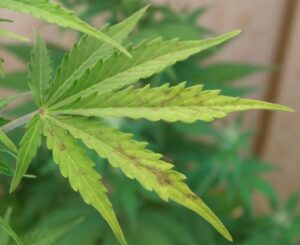
Picture below is what phosphorus deficiency looks like in flowering.
A phosphorus deficiency is often confused with fungus issues because of the appearance of the leaves. Colder temperatures (below 50℉/10℃) inhibit the absorption of phosphorus.
This picture shows phosphorus being locked out in a seedling due to cold temperature.

Phosphorus Toxicity
An excess in phosphorus suppresses the uptake of other nutrients like potassium, iron and especially zinc. A zinc deficiency is very common in the presence of excess phosphorus in plants. Plants with excess phosphorus will also have trouble absorbing copper. Phosphorus levels fluctuate when combined with calcium.
The two pictures below show phosphorus toxicity in cannabis.


Problems with Phosphorus being locked out by pH issues
Phosphorus can get locked out in cold, wet soil, compacted soil, as well as acidic or very alkaline soil. It is absorbed best in soil with pH levels between 6.0-7.5 and anything out of this range will contribute to a deficiency in this particular nutrient.
For hydro and soilless grow media, phosphorus gets locked out if pH levels are beyond 6.0. It is best absorbed at pH levels of 4.0- 5.8 and anything below or above this range will contribute to a phosphorus deficiency.
How to Fix Phosphorus Deficiency
- It is normal to experience a certain level of phosphorus deficiency during the flowering stage. However, you shouldn’t tolerate severe deficiency and must use supplemental feeding. Any fertilizer with phosphorus in it will fix the deficiency. Whether you go chemical or organic, just make sure you use an N-P-K ratio of over 5. Peters Professional General Purpose Fertilizer (20-20-20) is again a great choice. You can also opt for Miracle-Gro all-purpose plant food that has a good 24-8-16 mix.
- You can also give phosphorus supplements using bone meal, fish meal, bat guano, worm castings, soft rock phosphate or crabshell. Bone meal and fish meal are slow acting, so I recommend you make them into a tea for it to work faster. Crabshell and worm castings are also slow release supplements so if you want something that can be absorbed faster, choose rock phosphate or bat guano.
Below is a list of organic nutrients that can help fix phosphorus deficiency with their corresponding N-P-K ratio:
- Dr. Hornby’s Iguana Juice Bloom (4-3-6)
- Advanced Nutrients Mother Earth Bloom (.5-1.5-2)
- Fox Farm Big Bloom (.01-.3-.7)
- Earth Juice Bloom (0-3-1)
- Pure Blend Bloom (2.5-2-5)
- Pure Blend Pro Bloom (2.5-2-5)
- Budswell (0-7-0)
- Sea Island Jamaican Bat Guano (1-10-0)
- Indonesian Bat Guano (0-13-0)
- Rainbow Mix Bloom (1-9-2)
- Earth Juice Bloom (0-3-1)
- Bio-Bloom (2-6-3.5)
- Age Old Bloom (5-10-5)
- Alaska MorBloom (0-10-10)
- MetaNaturals Pro Organic Bloom (1-5-5)
When using organics, you’re less likely to experience nutrient burn compared to chemical fertilizers. However, remember to flush soil with plain water if you think you’ve overfed your cannabis plants. Use twice the amount of water as the size of your pot. Also, remember to monitor pH levels as these phosphorus supplements can either raise or lower pH levels in your growing medium.
Also, always remember to closely monitor pH levels in your growing medium when treating for nitrogen deficiency. Some of the recommendations above are acidic (fish meal and guano) and can bring pH levels down, while others are alkaline (bone meal, rock phosphate, shellfish and crabshell) and will raise pH levels.
Potassium (K)
Having good amounts of potassium in your plants aids in photosynthesis and water respiration, helps develop sturdy and thick stems, and makes them resistant to a host of diseases. Potassium is well distributed in all plant parts and is essential for all growth stages, especially during bud formation.
Potassium Deficiency
A lack of potassium in cannabis manifests as retarded growth and scorched leaf tips and edges. Stems can weaken and break easily. Older leaves may curl upward and show signs of necrosis (dead patches), turning yellow between the veins then moving outward until they die and fall off. Growth slows down when deficiency occurs during the vegetative stage. If deficiency occurs during flowering, there is a remarkable slowing down of bud growth.
A potassium deficiency can also be triggered by low relative humidity, cold weather, or when there’s an excess of other nutrients like calcium, sodium and ammonium nitrogen.
Pictures below show Potassium deficiency in cannabis.
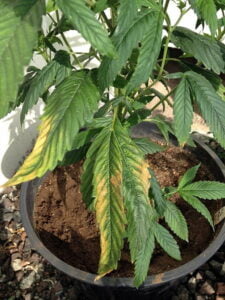
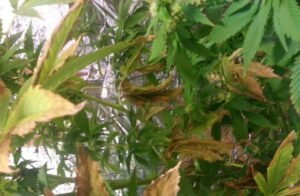
Potassium Toxicity
An excess of potassium in the soil can lead to issues like salt damage and acid fixation of the root system. The most visible sign of potassium toxicity in cannabis is a light yellow to whitish color between the veins of fan leaves. Potassium toxicity is rare as this macronutrient is usually not absorbed excessively by plants. When it occurs, however, it can reduce the uptake of a range of other nutrients like calcium, magnesium, manganese, iron and zinc.
As with any other nutrient toxicity, restore balance by flushing your soil with plain water. Use twice as much water as the size of your pot, so if you’re growing in a 4-gallon pot, use 8 gallons of water for flushing.
Picture below depicts potassium toxicity in cannabis.

Problems with Potassium being locked out by pH issues
When growing cannabis in soil, keep in mind that potassium gets locked out at pH levels of 4.0-5.5. A soil pH level of 6.0-9.5 is suggested for the best absorption of potassium, although I wouldn’t recommend going over a 7.0 pH just to be on the safe side.
If growing in hydroponics, maintain a pH level in the range of 4.7-5.3 and 6.7-8.5 for other soilless media. Potassium gets locked out at pH levels of 4.0-4.5 for hydro and 6.0-6.5 for other soilless grows.
How to Fix Potassium Deficiency
Just like nitrogen and phosphorus deficiencies, the lack of potassium in your grow medium is best addressed with any chemical or organic N-P-K fertilizer. Again, I suggest using Peter’s 20-20-20 or Miracle-Gro all-purpose plant food. When using chemical nutrients, mix at ½ strength to prevent nutrient burn.
If you want a quick solution, address potassium deficiency with wood ashes or FoxFarm Grow Big® Hydroponic Liquid Plant Food and Earth Juice Meta-K which are all fast-acting. Recovery can be observed in as little as 4 to 5 days with fast absorption supplements. Kelp meal, sulfate of potash, and sulfate of potash magnesia are medium absorption while greensand and granite dust are slow-absorption options.
As with other nutrient supplementation, monitor soil pH at all times.
Magnesium (Mg)
Magnesium helps support healthy veins while keeping healthy leaf production and plant structure. Magnesium is significant for the production of chlorophyll and the breakdown of enzymes. Magnesium must be present in relatively large quantities for the plant to survive, but not to a point where it will cause toxicity.
Magnesium Deficiency
Compared to other nutrient issues, a magnesium deficiency is easy to spot. The green veins, along with the yellowness of the entire surrounding leaf is a dead giveaway, but sometimes that’s not always the case. Other times, there is discoloration along leaf edges and tips which may also curl upward and feel dry and crispy. The inner section of leaves turn yellow or brown, then they fall off the stems without withering. New growth can turn lime green as the deficiency moves up the plant. Lower leaves are affected first, after which the middle and upper part will show symptoms as the plant grows older.
Among the worst cases that can happen is a magnesium deficiency caused by a pH lockout. You could be thinking you’re doing right by feeding your plant more magnesium to cure the problem, but actually, you’re doing more harm than good. When a plant is unable to uptake a nutrient because of pH being off, the nutrient remains in the soil and causes a buildup.
The picture shows a mid-grade magnesium deficiency.

Magnesium Toxicity
A little extra magnesium won’t harm your plants but excess levels will inhibit calcium uptake and cause dark-colored foliage and stunted growth. The plant will usually manifest symptoms of a buildup of toxic salts that will kill the leaves and lockout other nutrients like Calcium (Ca). On the other hand, excess calcium, ammonium, or chlorine in soil or water will lock out magnesium.
This picture shows excess magnesium in cannabis.

Problems with Magnesium being locked out by pH issues
Acidic soil and soil with high levels of calcium, potassium and phosphorus can lock out magnesium. So will soil pH levels of 2.0-6.4. Magnesium is best absorbed in soil when pH levels are between 6.5-9.1 although as previously mentioned, I suggest always keeping your soil pH below 7.0.
For hydro and soilless medium, a magnesium lockout occurs when pH levels are between 2.0-5.7. Best magnesium absorption occurs in 5.8-9.1 pH levels, although I recommend not going over 6.5 for hydro and soilless media.
How to Fix Magnesium Deficiency
Address a magnesium deficiency with chemical or organic nutrients containing magnesium. Mix at ½ strength when using chemicals to avoid nutrient burn. Other magnesium-packed options are Epsom salts and Earth Juice Microblast which are both fast absorption. Magnesia and sulfate of potash are medium absorption while dolomite (garden line) is slow absorption.
Calcium (Ca)
Calcium plays a vital role in plant cellular health – it is primarily responsible for holding together plant cell walls so the stems, stalks and branches remain sturdy and strong. It also plays a key role in new tissue formation such as root tips and young leaves, both of which will show distorted growth when there is a calcium deficiency.
Calcium Deficiency
When there is calcium deficiency in cannabis, it initially manifests in younger leaves where leaf tips may turn into a yellow or brown color, curl or die back. Overall plant growth is also stunted. There is visible weakness in stems and branches and the root system is underdeveloped. This can result in bacterial problems as some roots die off. Test your soil for acidity, as calcium is harder to absorb when your soil is acidic. Also, an excess of nitrogen or potassium will lock out calcium.
Pictures show calcium deficiencies. The first one shows early and the second one shows late development.


Calcium Toxicity
High levels of calcium will result in other micronutrient deficiencies in cannabis. Many types of growing media can cause calcium fixation – clayish soils, humus, and unbuffered coco are just a few examples, and it seems the lime bonds quite easily to these soils. Stems also weaken and will not be able to hold the plant up straight; there is also a white to brownish hue between the veins of the leaves.
Calcium toxicity in cannabis will look like this.

Problems with Calcium being locked out by pH issues
A lack of calcium can cause the soil to become very acidic. When growing cannabis in soil, best to keep soil pH between 6.5-9.1 for optimum absorption. Calcium gets locked out at 2.0- 6.4 pH levels.
In hydro and other soilless media, optimum absorption of calcium occurs at pH levels of 5.4-5.8. Calcium gets locked out at 2.0- 5.3 pH levels.
How to Fix Calcium Deficiency
Foliar feed with 1 tsp of dolomite or garden lime per quart of water to fix a calcium deficiency. You can also use 1-2 tsp per gallon of water and feed it directly to the soil. Any chemical or organic formulation containing calcium will correct a deficiency as well.
Other options include garden gypsum (great at breaking up clay and provides calcium without altering soil pH), rock phosphate, limestone, and animal wastes.
Note: Caution when using gypsum to already acidic soil (pH that is less than 5.5) as this can affect the absorption of soil aluminium, which is poisonous to plant roots.
As with all other nutrient feedings, you will need to flush out soil with plain water if you think you have added a bit too much. Rule of thumb is to use twice the amount of water as the size of your pot for a good rinse.
Zinc (Zn)
Zinc is an essential nutrient that aids in plant growth and maturity, particularly in the development of stalks, stems, branches and leaves. It is an essential component in enzymes and the growth hormone, auxin. Low auxin levels can result in stunting. Chlorophyll formation and activity are also propelled by zinc. Moreover, zinc helps with moisture absorption which is why plants with nice zinc levels tend to withstand long spells of drought better.
Zinc Deficiency
Bleached spots (chlorosis) between the veins of older leaves is the first sign of a zinc deficiency. This will then move on to younger leaves and slowly affect the tips of growing points. Because zinc is immobile in plants, symptoms mainly impact newer growths and will cause shorter shoots as well as shortening between the internodes. Another clearly visible sign is a clustering of small distorted leaves on plant tips.
A zinc deficiency almost always occurs with iron and manganese deficiencies because these three nutrients get locked out when soil or other grow medium pH is elevated.
The picture shows a zinc deficiency in vegetative growth.

Zinc Toxicity
A zinc toxicity happens when zinc levels in plant tissue exceed 200 ppm. Rarely does an excess of zinc occur, but when it does symptoms include retarded growth of the whole plant, smaller leaf size, necrotic leaf tips, chlorosis on younger or newer leaves and reduced root growth. General yellowing and wilting may also occur when there’s severe damage to roots due to high zinc concentration in soil.
An excess of zinc inhibits iron uptake and it is common to have symptoms of iron deficiency when there are toxic levels of zinc present.
This picture shows cannabis leaves drooping due to an excess of zinc.

Problems with Zinc being locked out by PH issues
Zinc gets locked out in soil lacking nitrogen and organic matter and soil with high pH and phosphorus levels. It is best absorbed when soil pH levels are between 5.0-7.0 and anything outside of this range will cause a deficiency.
In hydroponics and soilless media, zinc gets locked out at 5.7-8.5 pH. Optimal absorption is at pH levels of 4.0-5.5.
How to Fix Zinc Deficiency
Chemical or organic fertilizers containing any of the following nutrients will correct zinc deficiency in cannabis: zinc sulfate, chelated zinc, or zinc oxides. Another alternative would be to bury galvanized nails in soil, making sure to dull out sharp points to prevent root damage. Garden manure, cottonseed meal and greensand are also recommended for slow to medium absorption.
Iron (Fe)
Iron is an immobile element that contributes to leaf pigmentation and respiration in cannabis plants. It also interacts directly in the process of enzyme production. Plants absorb iron organically or in the form of ferric ion (Fe++). Iron reacts with other forms of nutrients which can contribute to a nutrient lockup. For instance, a phosphorus deficiency can take place if you supplement with iron without adding enough phosphorus. A pH imbalance will also make iron insoluble.
Iron Deficiency
Along with growing shoots, leaves on cannabis can turn a pale yellow when there’s lack of iron. The veins remain dark green but the tissue between them turns pale or white. Iron deficiency usually mimics magnesium deficiency, but discoloration is white where the yellow would be in the latter. This discoloration begins with the lower and middle leaves, while new leaf growths are completely lacking in chlorophyll. This chlorotic mottling first appears along the base of new leaflets.
Pictures below show iron deficiency.
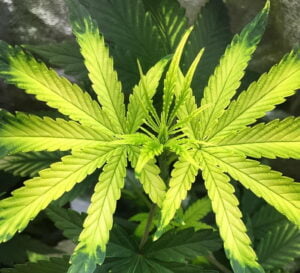
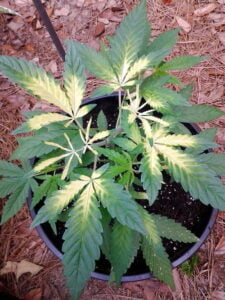
Iron Toxicity
Excess accumulation of iron in cannabis is rare but if it does happen, there could be bronzing or tiny brown spots on the surface of leaves. It can affect the whole plant but is usually the fan leaves that suffer most.
This picture shows iron toxicity.
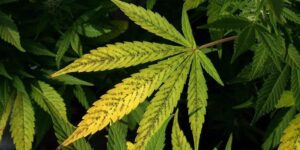
Problems with Iron being locked out by pH issues
A soil pH level of 4.0-6.5 is recommended for the optimal absorption of iron, which gets locked out when pH levels are at a low of 2.0-3.5. For hydroponics and other soilless grow media, pH levels of 5.0- 6.0 work best. Anything out of this range will lock out iron.
How to Fix Iron Deficiency
You can apply a foliar feed containing iron to fix a deficiency. Rusty water can also do a good job and if you’re looking for an organic iron source, garden manure is the most popular. Look for supplements that contain iron like ferric oxide, ferrous oxide, iron chelates and ferrous sulfate. All of these are fast-action supplements. If you’re looking for slow-action supplements, greensand and cottonseed meals are your best options.
Sulfur (S)
Sulfur is an immobile element just like iron. It plays a major role in vegetative growth and contributes much to chlorophyll supply and root development. Like iron, sulfur uptake is harder in hotter temperatures. Unlike iron, however, sulfur is evenly distributed throughout cannabis and mainly in big fan leaves.
Sulfur Deficiency
The first signs of a sulfur deficiency are pale young leaves which are narrower than usual and can become brittle. There may also be small mutated leaves, as well as buds on top of flowering plants that will eventually die off. Overall plant growth is stunted and stems will usually grow longer, but not thicker. They may also become hard and probably woody. Unlike a magnesium deficiency where yellowing begins at the leaf tips, yellowing in sulfur deficiency begins at the back of leaves moving forward towards the middle.
These pictures show a sulfur deficiency.

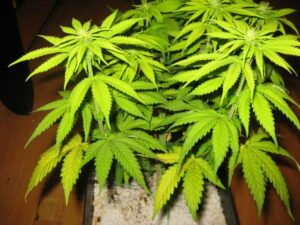
Sulfur Toxicity
Too much sulfur will cause stunted growth and smaller leaves. There will be browning of leaf tips which will cause leaves to look like they’re dying off. Sulfur toxicity looks pretty much like salt damage.
This picture shows sulfur toxicity in cannabis.
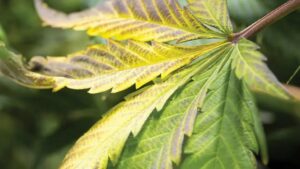
Problems with Sulfur being locked out by PH issues
Sulfur is absorbed best in soil at a pH level of 6.0- 9.5 (I wouldn’t recommend having a soil pH of over 7.0 in soil) Anything out of the ranges listed will contribute to a sulfur deficiency. Sulfur gets locked out of the soil at 2.0-5.5 pH levels.
In hydro and soilless media, the best range is at 5.0-6.0 ph levels.
How to Fix Sulfur Deficiency
To correct a lack of sulfur, mix 1-2 teaspoons of Epsom salts per gallon of water until the condition improves. Any organic or chemical nutrient fertilizer with sulfur may also be used. Mix at ½ strength when using chemicals so you don’t run into a nutrient burn problem.
Other great sources of sulfur are garden sulfur, gypsum, ammonium thiosulfate and rainwater. All of these have fast absorption properties.
Manganese (Mn)
Manganese contributes much to various plant biological systems such as nitrogen assimilation, photosynthesis, and respiration. Manganese is also vital in pollen germination, root cell elongation, and protection against root pathogens. It also helps break down enzymes for chlorophyll production and photosynthesis.
Manganese Deficiency
A lack of manganese manifests as spotted or mottled yellow or brown areas on young cannabis leaves. Necrotic yellow spots can be found on upper leaves while older leaves below may have greyish spots. The leaf veins may remain green.
These pictures show a manganese deficiency in flowering.
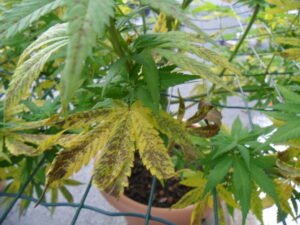

Manganese Toxicity
An excess of manganese in the soil will result in an iron deficiency and cause plants to become weak. Because there isn’t enough synthesis of chlorophyll, this accounts for the blotchy and mottled appearance of leaf tissue.
The picture below demonstrates manganese toxicity.

Problems with Manganese being locked out by PH issues
High iron and low nitrogen content in the soil, compacted soil, dry weather conditions, and soil pH of over 6.5 can all contribute to a manganese lockout. Manganese is best absorbed when soil pH levels are between 5.5 and 6.5 and anything outside of this range will result in a deficiency.
For soilless and hydro cannabis culture, pH levels should be at 5.0-5.6. Lockout occurs at 2.0-4.5 pH levels.
How to Fix a Manganese Deficiency
You can either do a foliar feed or water your cannabis with diluted chemical or organic fertilizer containing manganese. If using chemical-based fertilizers, mix at ½ strength to prevent nutrient burn. There are many forms of fast-absorption manganese that you can use:
- Manganese chelate
- Manganese carbonate
- Manganese chloride
- Manganese dioxide
- Manganese oxide
- Manganese sulfate
For slow or medium absorption, you can opt for greensand or garden manure. Always remember to flush your plants if you think you have given a little too much than needed.
Boron (B)
Boron and calcium work together in cell wall synthesis. Boron is also vital in cell division and creating new plant cells. Plants require more boron for reproductive growth so it is important to maintain healthy levels for successful pollination and seed development.
Boron Deficiency
Boron deficiencies will show up first in younger leaves (they may turn yellow), then move up the plant. Boron deficiency can resemble calcium deficiency. Symptoms include stunting, discoloration, the possible death of the growing tips, and bud abortion or development. Secondary roots will be swollen and the distorted leaves will be scorched or bronzed.
Plants are also at risk of having fungus issues when there is a boron deficiency because internal tissues and root hairs can rot away. To prevent a boron deficiency, you should keep the soil light and maintain soil pH levels lower than 7.
These pictures show a boron deficiency in different stages.


Boron Toxicity
Too much boron in your plants can produce a lot of problems. The leaf tips turn yellow, progressing inwards and causing the plant to soon die slowly along with leaves dropping a lot.
Boron deficiency can show the same signs as a magnesium deficiency but only happens on newer growths. The plant parts most affected are young leaves and growing points.
The picture below shows boron toxicity.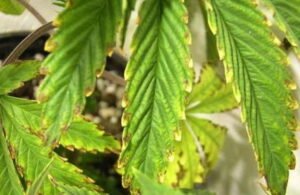
Problems with Boron being locked out by PH issues
Boron gets locked out in soil with pH levels under 5.5 or over 6.8. It is also more predominant in sandy soil or soil with low organic matter and where there’s a lack of nitrogen. For hydro and soilless grows, pH levels should be at 5.0 to 6.0 for best absorption. Anything out of these recommendations will result in boron deficiency.
How to Fix a Boron Deficiency
You can treat boron deficiency with one teaspoon of boric acid per gallon of water used as a foliar spray or watered on your cannabis. Boric acid is usually sold as eyewash. Garden manure and bone meal are great organic options rich in boron; however, they are slow and medium acting, respectively. There is a wide range of nutrients that contain boron. A few examples are borax, sodium pentaborate, sodium tetraborate, and colemanite, all of which are fast absorption.
As with all other treatments for nutrient deficiency, remember to flush out with plain water twice the amount as the size of your pot to get rid of excess nutrients and prevent nutrient burn.
Copper (Cu)
Copper plays a big role in producing healthy plants, stems, branches, and new growths. It also supports plant reproduction and maturity and assists in carbohydrate metabolism and oxygen reduction.
Copper Deficiency
Copper-deficient cannabis plants show irregular growth and wilting in newer growths. Growth tips die back, green leaves will show a bluish hue and plants may have a hard time showing maturity in vegging stages. There may be veinal chlorosis (bleaching of the veins) and necrosis in the upper leaves. Damaged leaves do not recover and yield is significantly diminished when there’s a lack of copper in cannabis.
Pictures below show a copper deficiency in cannabis. It may look like over-fertilization of nitrogen, but look at the bottom of the leaves. Notice how they yellow; also some of the fan leaf tips are brown and dying off.

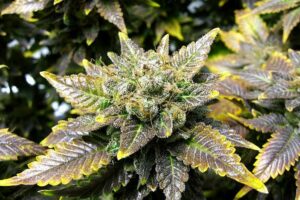
Copper Toxicity
Very high levels of copper act like a poison that can cause a plant to die. Towards the plant’s expiration, there will be decay in the root system and new growths will not open up. An iron deficiency will also be induced by copper toxicity.
Copper toxicity as seen in the picture below.

Problems with Copper being locked out by pH issues
Copper gets locked out when there’s a lack of nitrogen in soil that is highly compacted and pH level is high. It is best absorbed in soil with pH levels ranging from 5.0-7.5. For hydro and soilless media, pH levels should be between 2.0 to 6.0 as lockout occurs when pH is between 6.5 and 9.0.
How to Fix a Copper Deficiency
Foliar feed or water your cannabis with diluted copper sulfate or copper chelates to correct a copper deficiency. If using chemical fertilizers, use half-strength only to avoid nutrient burn. If you’re growing organic cannabis, greensand and garden manure may be used for copper supplementation. Remember to do some flushing with twice as much water as the size of your pot to prevent nutrient burn.
Molybdenum (Mo)
Molybdenum has proteins that help plants take nitrogen from the air. It is a vital component in the synthesis of amino acids within the plant.
Molybdenum Deficiency
When there’s a lack of molybdenum in cannabis, leaf growth is retarded and leaves will have a pale, fringed, and scorched appearance. The middle leaves will experience some yellowing, while younger leaves will twist and eventually die. Symptoms of molybdenum deficiency often appear similar to nitrogen deficiency and will occur when sulfur and phosphorus are also deficient.
The first picture below is a Molybdenum deficiency in new growth. The second pic is a Molybdenum deficiency in late flowering.


Molybdenum Toxicity
Molybdenum toxicity doesn’t cause too many problems with the plant; rather, problems can arise when humans ingest it. Excessive molybdenum in cannabis resembles copper or iron deficiency.
Molybdenum toxicity in picture below.

Problems with Molybdenum being locked out by pH issues
Molybdenum is locked out of soil when pH levels are between 2.0 and 6.5. It is most effectively absorbed when soil pH levels are at 7.0-9.5. In hydroponics and other soilless grow media, lockout takes place in pH levels of 2.0-5.5. Best pH values for hydros and soilless is 5.0-6.0.
How to Fix a Molybdenum Deficiency
All-purpose plant food like Miracle-Gro and Peters can help address a molybdenum deficiency. You can use this either as a foliar spray or to water cannabis directly. Organic options include greensand and lime which are slow and medium absorption.
When adding molybdenum or any other nutrient, don’t forget to flush soil with twice as much water as the size of your pot. This is crucial in preventing nutrient burn.
Get professional help for cannabis nutrient deficiencies
Nutrient deficiencies and pH issues are among the most common problems cannabis growers have to deal with. Ryan at Ant & Garden Organic Pest Control in Beaverton can provide you with the best solutions to your marijuana planting and growing issues. Advice and additional knowledge will be given with trusted and reliable facts – I provide quality service to all of NW Oregon and SW Washington.
I am the only person at Ant & Garden Organic Pest Control that will come to visit your garden. I have a keen eye for abiotic plant problems related to environmental conditions including air flow, humidity, pH, EC/PPM, temperature, light levels excess or deficiency.
I also analyze your light spectrum. Blue wavelengths will produce healthier plants and a higher yield than red wavelengths, but a red spectrum will produce more par watts in the same size bulb good for flowering. However, a mix of both gives full-spectrum and more terpenoids than either used individually.
I also check for nutrient imbalances. I will consult on all these issues so you can fix the underlying cause and we can root out if it’s a pest issue. I also provide treatments and consultations for biotic problems or environmental conditions to ease your mind on what’s hindering the full potential of your prized cannabis plants.

